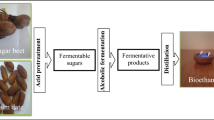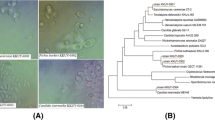Abstract
A solid standard mixture (SSM) representing the annual composition of fresh fruits and vegetables residues generated at the Supply Center in Mexico City was used for bioethanol production. This type of residues allows bioethanol production with a single thermal pre-treatment instead of hard thermochemical or enzymatic treatments. The release of fermentable carbohydrates from the SSM by a mild thermal pretreatment was firstly optimized. After that, mixed and single cultures of Saccharomyces cerevisiae, Scheffersomyces stipitis, and Schwanniomyces occidentalis were evaluated for bioethanol production. The maximum ethanol production, 282.61 ± 13.09 L ethanol per ton of dry matter (DM), was reached using a severity factor (SF) of 2.35 and a mixed culture composed of Saccharomyces cerevisiae, Scheffersomyces stipitis, and Schwanniomyces occidentalis. The improved lab scale conditions were evaluated in a pilot scale (18 Kg) stirred bioreactor with an SF of 2.35 and the mixed culture, obtaining 245.72 ± 17.76 L ethanol per ton DM. The obtained results demonstrate for the first time the use of fresh fruits and vegetables residues for bioethanol production under solid-state culture conditions without any thermochemical or enzymatic pre-treatment.
Similar content being viewed by others
References
Kumar Saini, J., R. Saini, and L. Tewari (2015) Lignocellulosic agriculture wastes as biomass feedstocks for second-generation bioethanol production: concepts and recent developments. Biotech. 5: 337–353.
Akbas, M. Y. and B. C. Stark (2016) Recent trends in bioethanol production from food processing byproducts. J. Ind. Microbiol. Biotechnol. 43: 1593–1609.
Gupta, A. and J. P. Verma (2015) Sustainable bio-ethanol production from agro-residues: a review. Renew Sustain Energy Rev. 41: 550–567.
Ballesteros, M., F. Saez, I. Ballesteros, P. Manzanares, M. J. Negro, J. M. Martinez, R. Castañeda, and J. M. Dominguez (2010) Ethanol production from the organic fraction obtained after thermal pre-treatment of municipal solid waste. Appl. Biochem. Biotechnol. 161: 423–431.
Schmitt, E., R. Bura, R. Gustafson, J. Cooper, and A. Vajzovic (2012) Converting lignocellulosic solid waste into ethanol for the State of Washington: an investigation of treatment technologies and environmental impacts. Bioresour. Technol. 104: 400–409.
Martínez-Valdez, F., C. Martínez-Ramírez, L. Martínez-Montiel, E. Favela-Torres, N. Soto-Cruz, F. Ramírez-Vives, and G. Saucedo-Castañeda (2015) Rapid mineralisation of the organic fraction of municipal solid waste. Bioresour. Technol. 180: 112–118.
Uçkun Kiran, E., A. P. Trzcinski, W. Jern Ng, and Y. Liu (2014) Bioconversion of food waste to energy: a review. Fuel. 134: 389–399.
Schimer-Michel, A., S. Flores, P. Hertz, G. Matos, and M. Ayub (2008) Production of ethanol from soybean hull hydrolysate by osmotolerant Candida guilliermondii NRRL Y-2075. Bioresour. Technol. 99: 2898–2904.
Cesaro, A. and V. Belgiorno (2014) Pre-treatment methods to improve anaerobic biodegradability of organic municipal solid waste fractions. Chem. Eng. J. 240: 24–37.
Li, A., B. Antizar-Ladislao, and M. Khraisheh (2007) Bioconversion of municipal solid waste to glucose for bio-ethanol production. Bioprocess Biosyst. Eng. 30: 189–196.
Palmqvist, E., J. Almeida, and B. Hahn-Hägerdal (1999) Influence of furfural on anaerobic glycolytic kinetics of Saccharomyces cerevisiae in batch culture. Biotechnol. Bioeng. 62: 447–454.
Taherzadeh, M. J., L. Gustafsson, C. Niklasson, and G. Lidén (2000) Physiological effects of 5-hydroxymethyl furfural on Saccharomyces cerevisiae. Appl. Microbiol. Biotechnol. 53: 701–708.
Negro, M. J., C. Alvarez, I. Ballesteros, I. Romero, M. Ballesteros, E. Castro, P. Manzanares, M. Moya, and J. M. Oliva (2014) Ethanol production from glucose and xylose obtained from steam exploded water-extracted olive tree pruning using phosphoric and as catalyst. Bioresour. Technol. 153: 101–107.
Zhi-Min, Z., W. Lan, and C. Hong-Zhang (2015) A novel steam explosion sterilization improving solid-state fermentation performance. Bioresour. Technol. 192: 547–555.
Pandey, A. (2003) Solid-state fermentation. Biochem. Eng J. 13: 81–84.
Kuhad, R. C., R. Gupta, Y. P. Khasa, A. Singh, and Y. H. P. Zhang (2011) Bioethanol production from pentose sugars: current status and future prospects. Renew. Sustain Energy Rev. 15: 4950–4962.
Tang, Y-Q., Y. Koike, K. Liu, M-Z. An, S. Morimura, X-L. Wu, and K. Kida (2008) Ethanol production from kitchen waste using the flocculating yeast Saccharomyces cerevisiae strain KF-7. Biomass Bioenerg. 32: 1037–1045.
Jeong, S., Y. Kim, and D. Lee (2012) Ethanol production by co-fermentation of hexose and pentose from food wastes using Saccharomyces coreanus and Pichia stipitis. Korean J. Chem. Eng. 29: 1038–1043.
Bader, J., E. Mast-Gerlach, M. K. Popovic, R. Bajpai, and U. Stahl (2010) Relevance of microbial coculture fermentations in biotechnology. J. Appl. Microbiol. 109: 371–387.
Saucedo-Castañeda, G., B. K. Lonsane, J. M. Navarro, S. Roussos, and M. Raimbault (1992) Potential of using a single fermenter for biomass build-up, starch hydrolysis, and ethanol production. Appl. Biochem. Biotechnol. 36: 47–61.
Arora, S., R. Rani, and S. Ghosh (2008) Bioreactors in solid state fermentation technology: Design, applications and engineering aspects: A review. J. Biotechnol. 269: 16–34.
Pandey, A. (1991) Aspects of fermenter design for solid state fermentations. Process Biochem. 26: 355–361.
Nava, I., I. Gaime-Perraud, S. Huerta-Ochoa, E. Favela-Torres, and G. Saucedo-Castañeda (2006) Penicillium commune spore production in solid-state fermentation of coffee pulp at laboratory scale and in a helical ribbon rotating reactor. J. Chem. Technol. Biotechnol. 81: 1760–1766.
Diaz-Campillo, M., N. Urtíz, Ó. Soto, E. Barrio, M. Rutiaga, and J. Páez (2012) Effect of glucose concentration on the rate of fructose consumption in native strains isolated from the fermentation of Agave duranguensis. World J. Microbiol. Biotechnol. 28: 3387–3391.
Overend, R. P., E. Chornet, and J. A. Gascoigne (1987) Fractionation of lignocellulosics by steam-aqueous pretreatments. Phil. Trans. R Soc. A. 321: 523–536.
Sluiter, A., B. Hames, R. Ruiz, C. Scarlata, J. Sluiter, D. Templeton, and D. Croker (2011) Determination of structural carbohydrates and lignin in biomass. Technical Report NREL/TP-510-42618. National Renewable Energy Laboratory. Golden, USA.
Sluiter, A., B. Hames, D. Hyman, C. Payne, R. Ruiz, C. Scarlata, J. Sluiter, D. Templeton, and J. Wolfe (2008) Determination of total solids in biomass and total dissolved solids in liquid process samples. Technical Report NREL/TP-510-42621. National Renewable Energy Laboratory. Golden, USA.
Bradley, R. L. Jr. (2010) Moisture and total solids analysis. pp. 17–27. In: Nielsen, S. S. (ed.) Food analysis, 4th edn. Springer, New York.
Saucedo-Castañeda, G., M. R. Trejo-Hernández, B. K. Lonsane, J. M. Navarro, S. Roussos, D. Dufour, and M. Raimbault (1994) On-line automated monitoring and control systems for CO2 and O2 in aerobic and anaerobic solid-state fermentation. Process Biochem. 29: 13–24.
Levenspiel, O. (1999) Chemical Reaction Engineering. 3rd edn. pp. 4140–4143. Wiley, New York.
Uçkun Kiran, E. and Y. Liu (2015) Bioethanol production from mixed food waste by and effective enzymatic pre-treatment. Fuel. 159: 463–469.
Maiorella, B., H. W. Blanch, and C. R. Wilke (1983) By-product inhibition effects on ethanolic fermentation by Saccharomyces cerevisiae. Biotech. Bioeng. 25: 103–121.
Bellido, C., S. Bolado, M. Coca, G. Gonzalez-Benito, and M. T. García-Cubero (2011) Effect of inhibitors formed during wheat straw pre-treatment on ethanol fermentation by Pichia stipitis. Bioresour Technol. 102: 10868–10874.
Horn, C. H., J. C. du Preez, and S. G. Kilian (1992) Fermentation of grain sorghum starch by co-cultivation of Schwanniomyces occidentalis and Saccharomyces cerevisiae. Bioresour Technol. 42: 27–31.
Kim, J. K., B. R. Oh, H.-J. Shin, C.-Y. Eom, and S. W. Kim (2008) Statistical optimization of enzymatic saccharification and ethanol fermentation using food waste. Process Biochem. 43: 1308–1312.
Wang, Q., H. Ma, W. Xu, L. Gong, W. Zhang, and D. Zou (2008) Ethanol production from kitchen garbage using response surface methodology. Biochem Eng J. 39 (3): 604–610.
Uncu, O. N. and D. Cekmecelioglu (2011) Cost-effective approach to ethanol production and optimization by response surface methodology. Waste Manage. 31 (4): 636–643.
Boluda-Aguilar, M. and A. López-Gómez (2013) Production of bioethanol by fermentation of lemon (Citrus limon L.) peel wastes pre-treated with steam explosion. Ind Crop Prod. 41: 188–197.
Canabarro, N., C. Alessio, E. Foletto, R. Kuhn, W. Priamo, and M. Mazutti (2017) Ethanol production by solid-state saccharification and fermentation in a packed-bed bioreactor. Renew Energy. 102: 9–14.
Salemdeeb, R., E. K. H. J. zu Ermgassen, M. H. Kim, A. Balmford, and A. Al-Tabbaa (2017) Environmental and health impacts of using food waste as animal feed: a comparative analysis of food waste management options. J Clean Prod. 140: 871–880.
Mazaheri, D., S. A. Shojaosadati, P. Hejazi, and S. M. Mousavi (2015) Bioethanol production performance in a packed bed solid-state fermenter: evaluation of operational factors and intermittent aeration strategies. Ann Microbiol. 65: 351–357.
Jeong, H., Y-C. Park, Y-J. Seong, and S. M. Lee (2018) Sugar and ethanol production from woody biomass via supercritical water hydrolysis in a continuous pilot-scale system using acid catalyst. Bioresour Technol. 245: 351–357.
Li, S., G. Li, L. Zhang, Z. Zhou, B. Han, W. Hou, J. Wang, and T. Li (2013) A demonstration study of ethanol production from sweet sorghum stems with advanced solid state fermentation technology. Appl Energ. 102: 260–265.
Acknowledgments
The authors are grateful to CONACYT, Mexico, for the research funding of PDCPN-2013/215467, and RJEM acknowledges the PhD scholarship (No. 265441) from CONACYT, Mexico.
Author information
Authors and Affiliations
Corresponding author
Additional information
Publisher’s Note
Springer Nature remains neutral with regard to jurisdictional claims in published maps and institutional affiliations.
Rights and permissions
About this article
Cite this article
Estrada-Martínez, R., Favela-Torres, E., Soto-Cruz, N.O. et al. A Mild Thermal Pre-treatment of the Organic Fraction of Municipal Wastes Allows High Ethanol Production by Direct Solid-state Fermentation. Biotechnol Bioproc E 24, 401–412 (2019). https://doi.org/10.1007/s12257-019-0032-7
Received:
Revised:
Accepted:
Published:
Issue Date:
DOI: https://doi.org/10.1007/s12257-019-0032-7




